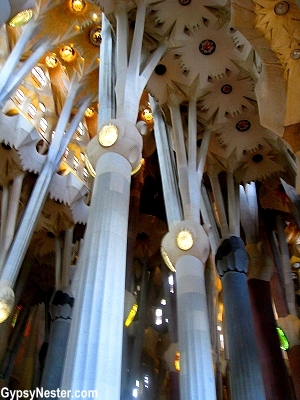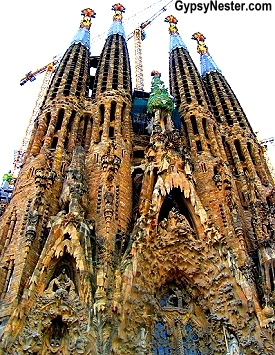
Barcelona had been on our wish list for a long, long time.
Nearly twenty years ago we tried to drive down from France in the middle of a frantic concert tour, but only made it as far as the beautiful little Catalonian coastal village of Roses.
There a net of fresh seafood, local libations, a nurses’ strike and deep discussions of regional and global politics with the citizens happily trapped us for a couple days, thus ending our southward journey.
This time, on our recent manic motorized blitz across Europe in good ol’ Benny, we finally made it to the capital of Catalonia.
Barcelona has many treasures, but one stood out to us above all the others, literally and figuratively, Sagrada Família. The massive basilica is without a doubt the pinnacle of architect and designer Antoni Gaudí’s incredible career. And we do mean pinnacle. Huge spires rise into the sky over fifty stories high – and it’s not even finished yet.

The church is still years, if not decades, away from completion and yet as we sat in awe for hours inside, trying to soak in every detail, we both agreed that this was the single most incredible building we’ve ever had the pleasure to enter.
There are no hard angles or straight lines within the church as everything emulates nature. Gaudí set out to make his series of columns that dominate the interior feel like giant trees in a forest.
Gazing up the enormous tapered pillars that split like branches, to provide structural support, as they ascended to the ceiling, we couldn’t help but conclude that he was wildly successful.

All of the lines curve and sweep, up staircases, around windows and even forming the alter.
Sagrada Familia is the pinnacle of Gaudi’s work, a part of the Catalan Modernism and Art Nouveau movements of Barcelona that is known in the Catalan language as Modernisme. The style is so fanciful that we felt as if we had stepped into a Dr. Seuss book.

As mesmerizing as the interior was, the outside demanded even more attention.
Our first impression was definitely dominated by the enormous scale of the building, but on closer inspection, it’s the details that make this structure even more amazing.
Three sides, all with entry ways, are decorated with incredible facades depicting the birth, death and glorification of Christ.

The Nativity Facade faces the rising sun as a reminder of new birth and was Gaudí’s effort to set the tone for the entire project.
Knowing he wouldn’t survive to see Sagrada Família’s completion, Gaudí chose to work on this facade first because he wanted the ornate style to influence the future of the construction.
He included many symbolic scenes and creatures from nature to represent land and sea, stability and change or simply the glory of creation. Natural forms and themes dominate his work.

In sharp contrast to the Nativity, The Passion Facade has a foreboding feel, in keeping with its somber subject matter.
The sculptures are harsh and angular, and absolutely fascinated us. Sculptor Josep Maria Subirachs wanted to use the sharp angles and block figures to accent shadows and highlight the contrasts of light and dark. The effect was superb.

The passion scenes occupy three levels. The first depicts Jesus’ last night before the crucifixion and includes The Last Supper, the kiss of Judas, and the trial of Jesus.
The middle portrays Calvary and the crucifixion. At the top the death, burial and resurrection of Christ are recreated.
A whimsical representation of Christ’s resurrection in the form of a statue sitting on a beam above all the chaos captured Veronica’s attention to the point that we clogged our hard drive with photos of it.

All of the figures’ faces capture the intense emotions of the events. The grief of Mary, compassion of Veronica and betrayal of Judas are all portrayed perfectly.
The Roman soldiers have the jawlines of Rockem – Sockem Robots and yet their expressions display a certain sympathetic feel. We must have spent an hour trying to absorb all of the details.

The final facade will serve as the main entrance and be the most spectacular of all but, unfortunately for us, is not completed yet. It will be dedicated to the glory of Christ and depict the path to God through death, judgment, and finally heaven, with hell waiting for those who stray.
This whole face of the building was covered with a gigantic canvas veil to keep the scene a secret until the work is ready for viewing. Of course we saw that as an invitation to try to sneak a peek, but were decidedly unsuccessful.
Thwarted, we proceeded to Gaudí’s workshop below the Sagrada Família. Here we found a fascinating glimpse into the designing, planning and construction of this masterpiece through sketches, photos, notebooks, models and prototypes.

Perhaps most interesting of these were the upside down string models of the towers that Gaudí used to calculate the effects of gravity on the load bearing portions of the building.
By placing weights at what would be the peaks of all of the spires on his string structure, and overturning it to allow gravity to do its thing, he could reverse engineer the results to provide for the opposite forces on the upright finished product. Genius we’d say.

Going through the displays chronicling the over a century of construction since work began in 1882, it occurred to us that Sagrada Família is very much in the tradition of the famous old cathedrals of Europe.
Not only in its grandeur, but also in the way that several generations of workers, artists and architects will participate in the creation. We found a huge part of our attraction to this great building was in the feeling of seeing a timeless monument being created.

We wandered through the exhibits until security herded us out the door for closing time, but still weren’t ready to leave this awesome structure.
We took another walk all the way around the outside and then figured we should grab a bite to eat, mmm, perhaps some paella.
Sitting in an outdoor cafe, in sight of the basilica, we waited on tenterhooks for the sun to set and the lights to flood Sagrada Familia.
Glad we did because the Sagrada Família stood out against the night sky in a way that made it even more mesmerizing.
As if that were possible.
David & Veronica, GypsyNester.com
Delve Deeper into Barcelona:
The Gothic Quarter and La Rambla
Eating Tapas
Gaudí or Gaudy – You Decide



Hi there, I log on to your new stuff on a regular basis.
Your story-telling style is witty, keep up the good work!
I every time spent my half an hour to read this blog’s posts all the time along with a cup of coffee.
I was in Barcelona summer before last and really enjoyed my visit to La Sagrada Familia. It’s a beautiful and fascinating building with an interesting interesting. Gaudi was innovative in some many ways. I love the feeling of openness and peace inside the sanctuary. I have very similar photos. Thanks for bringing back a pleasant memory.
Our pleasure Donna, it’s such a great building. We really want to go back and see how it has progressed.
Great perspectives in your pictures! I can’t believe they are still doing construction on the Basilica
Thanks Sam!
I’d say this is the most amazing building of the world!
So beautiful! I was in Barcelona several years ago and was amazed at the Sagrada Familia then, even with more than half of it under ugly construction blankets and beams. Gaudi is truly an amazing architect – and this is one of his best.
It’s the only building I’ve ever seen that I would compare to things in nature like mountains, or the Grand Canyon. It’s that incredible.
Amazing place! Always wished to go there!
This is the best description/post I’ve ever read about Sagrada Familia. It was 6 years ago since I explored it, and even though I was recovering from the worst food poisoning of my life that day I didn’t want to leave either. Reading your description I can see that I missed things, or perhaps they weren’t available to be seen then.
I love Barcelona, and partly because there is such a rich tradition of art and architecture there, and so much history from so many different eras. I take a few “sights” or places at a time (four visits so far). This Fall I went to Parc Güell and from there the vista of the city is breathtaking….and for me utterly dominated by Sagrada Familia, it really is even larger than I thought when at ground level.
Lovely post.
Wow. Thanks! My guess is that a lot of work has been done in the six years that you’ve “been away.” It’s amazing how much work is being done every day – a true work in progress!
At first, I hesitated to go inside Sagrada Familia but I’m so glad it did. It is really amazing to be standing inside a tourist attraction that is a work in progress.
Wow! Adding this to my bucket list of places to go! Gorgeous! Thank for sharing!
Glad to, and you definitely should.
La Sagrada Familia really takes your breath away, doesn’t it… Sadly, the last few times I’ve been in Barcelona, it has been more or less covered in scaffolding.
We were so happy that the two facades are completely open – but are going to have to go back when the last is finished – the drawings we saw in the workshop are out of control! And can you imagine how awesome the center spire will be?
Wow, this church is INCREDIBLE. We made it to Barcelona a few years ago; we only spent a day there with another person, so somehow we missed seeing this. Que horror – clearly we need to go back!
Hahaha! You now have a FANTASTIC excuse to go back to beautiful Barcelona!
Wow! Thanks for such an informational tour – Bucket List: see Barcelona’s Basilica
Get ’em tiger!
Thank you so much for sharing your life travels…I just got my first newsletter link and trully enjoyed it. I applaud your courage to do what your doing…I love to travel, but, to make a life of it…wow!
Thank you for coming along with us – looking forward to having you along for the ride! -David & Veronica